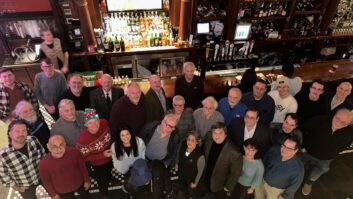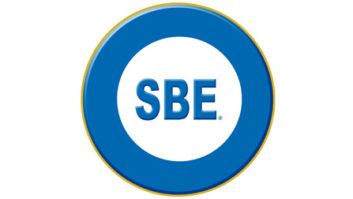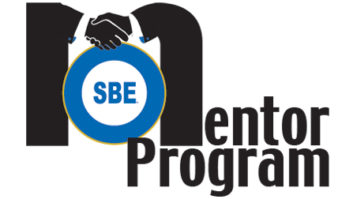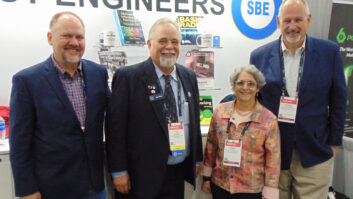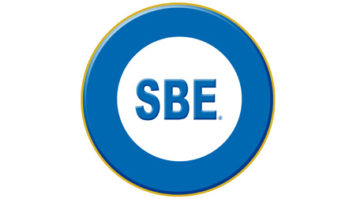The SBE/NFL Game-Day Coordinators
Apr 1, 2001 12:00 PM, By Mark Krieger, CBT
The year is 1998. The setting is a professional football stadium in a large midwestern city. Technicians and crews have been working on and off for the past 24 hours in preparation for an NFL national broadcast. On the sidelines, coaches, equipment managers and player personnel for each team make last-minute preparations as the scoreboard clock rolls down to kickoff � it’s showtime.
Behind the visiting team bench, a documentary videographer prepares as his soundman switches on his equipment and performs level checks. Meanwhile, an on-field color commentator on the opposing sideline looks up in confusion as his IFB link, functioning perfectly moments before, drowns in a distorted wail.
Just after kickoff, the quarterback is forced to burn a precious time-out because he cannot hear the play call of the offensive coach in his in-helmet receiver. The transmission has been buried by the conversation of a local trucking executive and his brother-in-law, who decided to bring a couple of the company walkie-talkies to the game so they could �keep in touch� from their respective seats.
All in all, these events were not the kind of �contact sport� that teams, fans and broadcasters had come to expect at an NFL event � and it was a game in which the participants would rather not have played. Unfortunately, by the late 1990s, scenes similar to this one were becoming common.
Recognizing the need
Issues of RF interference and compatibility are as old as radio itself. Yet the proliferation of wireless devices of all types, coupled with the diminishing technical consciousness of their users, has resulted in a geometric increase in the occurrence of �wireless collision.� This unforeseen byproduct of the current technology boom has left professional sports producers, among others, scrambling to stave off the effects of electromagnetic chaos.
Fortunately, the Society of Broadcast Engineers has long attracted a membership with a wealth of knowledge and skill in spectrum management. As a result, SBE frequency coordinators are now called upon to lend their special skills at a variety of major sporting events, such as all-star games, major auto races, and even golf tournaments.
In the case of the NFL, an appreciation for the value of efficient spectrum management originated with the Super Bowl, unquestionably the highest stake, most heavily produced single event in professional sports. It was during the season leading up to Super Bowl XXX that Jay Gerber of NFL Films asked SBE frequency coordinator Karl Voss to directly participate in the event coordination effort at the behest of the NFL’s special events division. The results, according to Gerber, were �impressive,� and later led to a deliberation on whether such a program should be adopted across the league.
According to SBE and NFL personnel, the evolution of the league-wide frequency coordination program was epic in nature. This wasn’t unexpected, given that issues of trust and control are most sensitive in any negotiation where broad contrasts exist between organizational cultures. The NFL and SBE were no exception to this rule, and it took years, not months, to reach a consensus on the plan.
A detailed chronicle of that process would fill a book. But the very existence of the program today speaks volumes about the tremendous patience and hard work contributed to the effort by individuals from both organizations.
The coordinator’s perspective
At its core, the Game-Day Frequency Coordination program is largely a local operation. For every NFL venue, the SBE provides a voluntary coordinator, sometimes with an assistant, who handles all phases of that stadium’s coordination. These individuals have at their disposal a standard NFL-issued equipment kit, consisting of a laptop PC with special software, a high-quality broadband radio receiver, and a handheld frequency counter. In addition, most coordinators pack their own set of binoculars, cell phones, and some type of hand-held scanner. In markets where spectrum congestion is particularly notorious, and during playoff and championship games, more sophisticated tools, such as spectrum analyzers and Doppler DF hardware, may be deployed.
While the action is local, frequency coordinators are in constant touch with SBE and league officials via an e-mail list server. The e-mail list also allows local coordinators to share their knowledge and experiences, making it one of the most valuable resources in the program.
To say that the coordinator’s task is complex understates the issues involved. To begin with, the SBE has no official coordination authority beyond those frequencies eligible to broadcasters under Part 74. This means that non-broadcast auxiliary frequencies such as those covered by Part 90 (business) are coordinated by other entities. Furthermore, coordination authority doesn’t impart enforcement authority of any kind and relies, instead, on voluntary cooperation. Thus, any ability to enforce compliance with a coordination plan rests with the team that controls the stadium and has the authority to withhold or revoke working credentials.
Though such sanctions aren’t to be taken lightly, professional ethics render them largely symbolic in nature. Cooperation, not coercion, is what drives the program’s success. Even Part 90 users realize that interference-free operations ultimately benefit everyone involved, and they are generally responsive to the informational advisories provided by coordinators.
The realities of spectrum beyond the stadium gates are one more factor that the coordinator has to consider. To facilitate this, the game-day coordination database is linked to the Percon database, allowing a one-key look at local users on a given frequency, along with the distance and bearing. With this, the coordinator can offer heads-up warnings and alternate frequency suggestions to users who coordinate in advance on non-Part 74 frequencies. The game-day coordinator always works hand-in-glove with the local SBE coordinator (if he is not one and the same) to assure a smooth interface with local Part 74 users.
Prior preparation
Advance coordination is the linchpin of the SBE/NFL program. The coordination process really begins about four weeks before the exhibition season. During this period, the coordinator makes contact with local team representatives, stadium officials and technicians, and home radio broadcasters to build the list of frequencies and users that constitute the static portion of the database for the season. This includes referee wireless microphones, handheld wireless microphones for pre-game and half-time, Camlink and Coachcom wireless links, IFBs and other broadcast wireless devices, as well as two-way radio equipment in use by stadium security, vendors, and other workers and officials. All told, this list alone can contain hundreds of frequencies.
In the database software, all low-power operations in unused TV channels are automatically checked against local TV/DTV operations, and any conflicts are flagged on entry, saving enormous labor. Another asset of the system is its ability to factor in bandwidth when calculating potential conflict. Since microwave video hops are included in coordination efforts, a detailed database is essential.
Although the program flags all potential conflicts according to entered parameters, the database is no substitute for the RF experience of a coordinator. The database cannot predict intermodulation product generation, nor can it foretell the effects of blanketing interference, where broadcast booths and their associated antenna arrays are locked together in close quarters. These issues are left for resolution on game day.
As the season progresses, traveling media submit their frequency requests ahead of time via e-mail to the central SBE coordination address, which then automatically forwards it to the appropriate coordinator. Regardless of when the information is submited, it’s the coordinator’s job to enter the data and provide the appropriate clearances or alternate recommendations. Each game day is saved as a separate file, automatically incorporating the static season data with the itinerant users at a given game. On the day of the game, the game day coordinator can print a complete profile of the day’s users for easy reference.
The game-day experience
The coordinators typically set up in the press box or other league-provided vantage point several hours before the game. Soon thereafter, they may walk through the venue; through home and visiting team sideline operations, TV, radio, and stadium audio/video operating locations. This tour serves several functions. First, it allows a coordinator to make contact and uncover emerging conflicts early. Second, it serves to confirm that all parties are in compliance with the day’s coordination plan. Finally, it builds mutual confidence and rapport between those sharing spectrum and the coordinator. Any last minute adjustments to the day’s coordination plan are usually made at this time.
Returning to the press box, the coordinators begin monitoring key frequencies (such as the critical coach-to-QB channels) for potential interference. Visual sweeps of the field and sideline areas with binoculars can spot any wireless gear that may not have been previously coordinated. Previous experience with the venue and the media players comes heavily into play at this point, as a seasoned coordinator is often able to sort new, uncoordinated arrivals from the other media visually. A potential interferer can then be intercepted and queried regarding his intent to use wireless equipment and whether he has complied with league policy. In most cases, these parties are quite cooperative with the effort, and the hand-held frequency counters quickly determine usage, allowing on-the-spot coordination.
After a final flurry of activity, the coordinators settle down in their seats and monitor the action. In general, most conflicts are resolved by kickoff, and while some problems may emerge later in the game, they are an exception. The ability to sit through the entire game without the disruption of a distress call provides the coordinator with a distinct and satisfying sense of accomplishment.
The final threat to a collision-free event occurs during the last minutes of the game as wireless equipment moves to the locker rooms. Uncoordinated local press can provide a few unexpected thrills at this time.
Finally, the last notes are made, the gear packed up, and the coordinator is ready for the long march through ranks of homeward-bound fans. As the process prepares to recycle for the following week, feedback via the e-mail list server filters in from around the country. This is a time when coordinators can sit back, relax and share their experience. All told, they have probably given up a couple of hours during the week handling pre-game coordination, along with about six hours of activity on game day. All of this time is voluntary. While the program does provide a reimbursement plan to cover phone, transportation and administrative expenses, the rewards of serving as a coordinator are limited to the satisfaction of being part of an effort to support other broadcast and media professionals.
Final thoughts
The SBE/NFL game-day frequency coordination program is still very much a work-in-progress. Improved software is being prepared for distribution, while lessons learned during the season are being reviewed. With the benefit of this year’s experience, the Fall 2001 season is likely to flow more smoothly for everyone involved.
It would be disingenuous to say that the program has been without its critics. Some have questioned whether the material benefits the SBE garners from its relationship with the NFL are worth the effort expended. Still others, apparently unaware of the escalation of event-intensive interference, have argued that the program is superfluous and unwarranted.
Such views overlook a broader perspective � one that reveals SBE gaining valuable experience and stature as an organization preparing for a new role in a new century. The degree to which the SBE assumes that role depends largely on the commitment and dedication of its members, and the goodwill and confidence of its partners in the American broadcast industry. The SBE/NFL frequency coordination program appears to be a step in the right direction.
Mark Krieger, BE Radio’s consultant on contract engineering, is also the SBE/NFL game day coordinator for Cleveland.
Photos of Super Bowl XXXV are courtesy of Ralph Beaver





